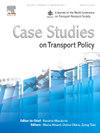Transit network design: A sustainability-oriented methodology for the management of large bus networks and low emission zones
IF 2.4
Q3 TRANSPORTATION
引用次数: 0
Abstract
The present paper proposes a methodology aimed at design bus public network suited to serve high-sensitive zones of the study area with low-impact vehicles. The purpose is to provide a procedure for support a smart electrification of public transport bus network, optimizing the use of electric vehicles where it is most effective to operate them. The new methodology solves a Transit Network Design (TND) problem where the optimization model consists of minimizing costs and resources in a public transport network also including sustainability issues. Therefore, starting from the method presented in Cipriani et al. (2012), the issue is framed as a multi-objective model, combining two objectives: the classic TND objective and the second related to the identification of the use of electric vehicles where it is most effective to operate them. The complexity of such issues needs metaheuristic algorithms application, in which the GA permits to obtain Pareto optimal non dominated solutions for the TND. Such solutions are then exploited as a multi-objective analysis, treating conventional objectives and objectives for a better use of electric vehicles, separately. The methodology has been implemented in a case study in the city of Rome. The findings demonstrate the effectiveness of methodology to design robust public transport supply system suited to serve high-sensitive zones.
公交网络设计:大型公交网络和低排放区管理的可持续发展导向方法
本文提出了一种设计方法,旨在设计适合于研究区域高敏感区域的低影响车辆的公共汽车网络。目的是提供一种支持公共交通公交网络智能电气化的程序,优化电动汽车的使用,使其最有效地运行。新方法解决了交通网络设计(TND)问题,其中优化模型包括最小化公共交通网络的成本和资源,并包括可持续性问题。因此,从Cipriani等人(2012)提出的方法开始,这个问题被构建为一个多目标模型,结合了两个目标:经典的TND目标和第二个与确定电动汽车的使用最有效的操作相关的目标。这类问题的复杂性需要应用元启发式算法,其中遗传算法允许获得TND的帕累托最优非支配解。然后将这些解决方案作为多目标分析加以利用,分别处理传统目标和更好地使用电动汽车的目标。该方法已在罗马市的一个案例研究中得到实施。研究结果表明,设计适合高敏感地区的稳健公共交通供应系统的方法是有效的。
本文章由计算机程序翻译,如有差异,请以英文原文为准。
求助全文
约1分钟内获得全文
求助全文

 求助内容:
求助内容: 应助结果提醒方式:
应助结果提醒方式:


